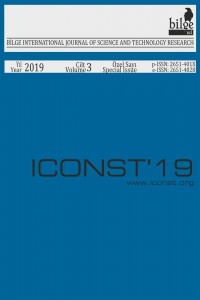Abstract
References
- Aradi, B., Hourahine, B., Frauenheim, T. (2007). DFTB+, a Sparse Matrix-Based Implementation of the DFTB Method. J. Phys. Chem. A 111, 5678-5684.
- Barzinjy, A. A., Mustafa, S., Ismael, H. H. J. (2019). Characterization of ZnO NPs Prepared from Green Synthesis Using Euphorbia Petiolata Leaves. EAJSE 4, 74-83.
- Chang S-P., Chen, K-J. (2012). Zinc Oxide NP Photodetector. J. Nanomater. 2012, 1-5.
- Czajkowski, M. A., Koperski, J. (1999). The Cd2 and Zn2 van der Waals dimers revisited. Correction for some molecular potential parameters. Spectrochim. Acta, Part A 55, 2221-2229.
- Gaus, M., Goez, A., & Elstneri, M. (2013). Parametrization and Benchmark of DFTB3 for Organic Molecules. J. Chem. Theory Comput. 9, 338-354.
- Kubillus, M., Kubař, T., Gaus, M., Řezáč, J., & Elstner, M. (2015). Parameterization of the DFTB3 Method for Br, Ca, Cl, F, I, K, and Na in Organic and Biological Systems. J. Chem. Theory Comput. 11, 332–342.
- Kurban, M. (2018). Size and composition dependent structure of ternary Cd-Te-Se nanoparticles. Turk. J. Phys. 42, 443-454.
- Kurban, M. Malcıoğlu, O. B. Erkoç Ş. (2016). Structural and thermal properties of Cd-Zn-Te ternary NPs: Molecular-dynamics simulations. Chem. Phys. 464, 40-45.
- Kushwaha, A. K. (2012). Lattice dynamical calculations for HgTe, CdTe and their ternary alloy CdxHg1−xTe. Comp. Mater Sci. 65, 315-319.
- NIST Standard Reference Database (2019). Experimental bond lengths. https://cccbdb.nist.gov/expbondlengths1.asp. (Access Date: 10.05.2019).
- Wang, CL., Zhang, H., Zhang, JH., Li, MJ., Sun, HZ., Yang, B. (2007). Application of Ultrasonic Irradiation in Aqueous Synthesis of Highly Fluorescent CdTe/CdSCore-Shell Nanocrystals. J. Phys. Chem. C111, 2465-2469.
- Wu, X., Wei, Z., Liu, Q., Pang, T., Wu, G. (2016). Structure and bonding in quaternary Ag-Au-Pd-Pt clusters. J Alloy. Compd. 687, 115-120.
- Yang, P., Tretiak, S., Masunov, A. E., Ivanov, S. (2008). Quantum chemistry of the minimal CdSe clusters. J. Chem. Phys. 129, 074709-1—074709-12.
- Zhang, Y., Nayak, TR., Hong, H., Cai, W. (2013). Biomedical applications of zinc oxide nanomaterials. Curr. Mol. Med. 13(10), 1633-1645.
Controlling structural and electronic properties of ZnO NPs: Density-functional tight-binding method
Abstract
We carried out a thorough examination of the
structural and electronic features of undoped and Nitrogen (N)-doped ZnO
nanoparticles (NPs) by the density-functional tight-binding (DFTB) method. By
increasing the percent of N atoms in undoped ZnO NPs, the number of bonds (n),
order parameter (R) and radial distribution function (RDF) of two-body
interactions such as Zn-Zn, N-N, O-O, N-O, etc. were investigated using novel
algorithms. Our
results show that the total n
of Zn-Zn interactions is greater than that of Zn-Zn, N-N, N-O, and O-O; thus,
it means that Zn atoms have a greater preference for N or O atoms. The RDFs of Zn and O atoms
increase based on the increase in the content of N atoms. The R of Zn, O and N atoms demonstrate that O
and N atoms tend to locate at the center, whereas Zn atoms tend to reside on
the surface. The density of state (DOS) indicates that the undoped and
N-doped ZnO NPs demonstrate a semiconductor-like behavior that is coherent with
measured data. The HOMO-LUMO energy gap decreases from -4.717 to -0.853
eV. n increase in the content of N atoms contributes to the destabilization of
ZnO NPs due to a decrease in the energy gap.
References
- Aradi, B., Hourahine, B., Frauenheim, T. (2007). DFTB+, a Sparse Matrix-Based Implementation of the DFTB Method. J. Phys. Chem. A 111, 5678-5684.
- Barzinjy, A. A., Mustafa, S., Ismael, H. H. J. (2019). Characterization of ZnO NPs Prepared from Green Synthesis Using Euphorbia Petiolata Leaves. EAJSE 4, 74-83.
- Chang S-P., Chen, K-J. (2012). Zinc Oxide NP Photodetector. J. Nanomater. 2012, 1-5.
- Czajkowski, M. A., Koperski, J. (1999). The Cd2 and Zn2 van der Waals dimers revisited. Correction for some molecular potential parameters. Spectrochim. Acta, Part A 55, 2221-2229.
- Gaus, M., Goez, A., & Elstneri, M. (2013). Parametrization and Benchmark of DFTB3 for Organic Molecules. J. Chem. Theory Comput. 9, 338-354.
- Kubillus, M., Kubař, T., Gaus, M., Řezáč, J., & Elstner, M. (2015). Parameterization of the DFTB3 Method for Br, Ca, Cl, F, I, K, and Na in Organic and Biological Systems. J. Chem. Theory Comput. 11, 332–342.
- Kurban, M. (2018). Size and composition dependent structure of ternary Cd-Te-Se nanoparticles. Turk. J. Phys. 42, 443-454.
- Kurban, M. Malcıoğlu, O. B. Erkoç Ş. (2016). Structural and thermal properties of Cd-Zn-Te ternary NPs: Molecular-dynamics simulations. Chem. Phys. 464, 40-45.
- Kushwaha, A. K. (2012). Lattice dynamical calculations for HgTe, CdTe and their ternary alloy CdxHg1−xTe. Comp. Mater Sci. 65, 315-319.
- NIST Standard Reference Database (2019). Experimental bond lengths. https://cccbdb.nist.gov/expbondlengths1.asp. (Access Date: 10.05.2019).
- Wang, CL., Zhang, H., Zhang, JH., Li, MJ., Sun, HZ., Yang, B. (2007). Application of Ultrasonic Irradiation in Aqueous Synthesis of Highly Fluorescent CdTe/CdSCore-Shell Nanocrystals. J. Phys. Chem. C111, 2465-2469.
- Wu, X., Wei, Z., Liu, Q., Pang, T., Wu, G. (2016). Structure and bonding in quaternary Ag-Au-Pd-Pt clusters. J Alloy. Compd. 687, 115-120.
- Yang, P., Tretiak, S., Masunov, A. E., Ivanov, S. (2008). Quantum chemistry of the minimal CdSe clusters. J. Chem. Phys. 129, 074709-1—074709-12.
- Zhang, Y., Nayak, TR., Hong, H., Cai, W. (2013). Biomedical applications of zinc oxide nanomaterials. Curr. Mol. Med. 13(10), 1633-1645.
Details
| Primary Language | English |
|---|---|
| Subjects | Material Production Technologies |
| Journal Section | Research Articles |
| Authors | |
| Publication Date | December 31, 2019 |
| Acceptance Date | December 23, 2019 |
| Published in Issue | Year 2019 Volume: 3 |


